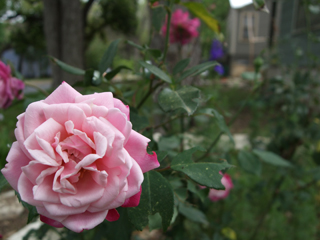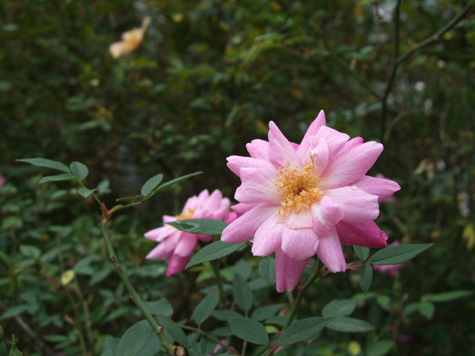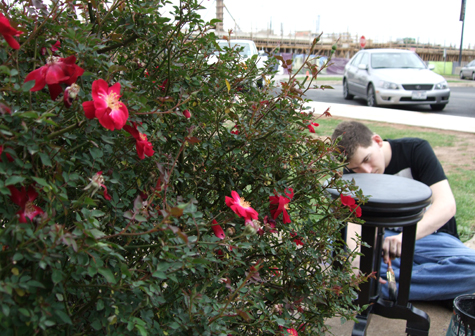Human Flower Project
Wednesday, April 02, 2008
Copycat Gardening with China Roses
Many dead rose bushes along in gardening, brute imitation looks like a better and better approach, whether it’s “sincere” or not.

Archduke Charles, China rose that survives in Austin, TX
Photo: Human Flower Project
“Imitation is the sincerest form of flattery,” we’ve been told, a maxim we have always detested for trying to take copycats off the hook. As if “flattery” were a good thing! We’re not even all that keen on “sincerity.”
When it comes to Central Texas gardening, though, we now embrace copycatting with both freckled arms. This has nothing to do with flattery or virtue – it’s the distinct pleasure of survival. Lime soil and 112 degree summer days make lily of the valley, peonies, bearded iris, and camellias (the list goes on…) experiments in hubris, and after a decade in Austin, we’ve failed enough of those tests. Now melted into submission (a.k.a. imitation), we have a few blooming plants to show for it.
Some of the finest are China roses. Thanks to Lynnette for this succinct description: “Introduction of roses from China started the continual flowering of modern roses. These Chinas are slender, open shrubs that bear large clusters of small flowers throughout the summer months. They do need a sunny and protected site to grow well in.”

Rouletii after a rainshower, with Mutabilis behind it
Photo: Human Flower Project
This spring seems to have been exceptionally cool and fresh. There was a whale of a rain in early March that set the roses off magnificently, and as M. Sinclair Stevens noted at Zanthan Gardens, the drop-down worms are either late or mysteriously absent this year. Consequently, our China roses – and those all across the city—are putting on a prolonged show – timely for the Garden Bloggers Spring Fling. (Kudos to Melissa and Pam Penick, Diana Kirby and Bonnie Martin for divine intuition as well as crack planning!)
Before moving to Austin, we’d never heard of China roses and, honestly, they took some getting used to. Compared to hybrid teas, the plants tend to be bushy, sprawling,—shapeless, really. The flowers are smaller than most later rose varieties, and some of the colors are strident. Off putting? Indeed. It took several years of killing, first, Bourbon roses (Coquette des Blanches and Mme. Issac Perriere), and then early hybrid teas (Sombreuil, Mrs. Oakley Fisher and Lafter) for us to quit daring and start copy-catting.

Copycattable rose Ducher, with loads of blooms this spring
Photo: Human Flower Project
Looking around, we spotted Scott Thurman’s white China rose Ducher blooming intermittently nearly half the year. In a locale with as many microclimates as Austin (also the confluence of several soil zones), it’s best to imitate immediate neighbors. With Scott just two doors down, Ducher was the first China rose we tried. It’s having a super spring, and we plan to buy another one or two this fall—the best time to plant anything here.
Morton King first put us on to Archduke Charles (known as the “Sam Houston Rose” where he lives, Georgetown, Texas). When we spotted several healthy bushes of it blooming like mad four blocks away, we bought a couple of these shrubs, too. Like a number of Chinas, they are multicolored roses, blooming pale pink and darkening to deep crimson as the flowers age.

Mutabilis: a big, shaggy, multi-colored survivor in Austin
Photo: Human Flower Project
One of the most popular roses around Austin is Mutabilis, a China rose that grows to be about the size of a Prius. We first noticed Mutabilis in Gretchen Heber’s yard, amazed that it was a rose at all. The buds are melon orange, the blooms are golden yellow, and then turn pink. In full bloom, a Mutabilis shrub looks like it’s covered with ribbons.
Rouletti is a more compact China rosebush, with smaller flowers too, a slightly purply shade of pink. Dick Stanley and Debra Davis, who no longer live in the ‘hood, bequeathed a fine rouletti hedge to Travis Heights that blooms faithfully each spring.

Rico Shay, Dinah, Bill and Old Blush, April 2, 2008
Photo: Human Flower Project
Certainly the best known of the Chinas is Old Blush. Many rosarians say that it was among the first Chinas (Rosa chinensis) to come to European gardens in the 18th Century, the ancestor of many a Portland, Bourbon, and Noisette. (For loads more on the genealogy of China roses look here and here. And you might also like this article on the wild roses of Southern China, where it all began.)
Pam Puryear, whose rose gardening so many other Texans have copy-catted, called this her favorite. Her friend, horticulturist and author William Welch writes, “”My own interest in old roses began when I was a child, back in the mid-1940 as I watched my aunt Edna carefully planting a hedge of the China rose ‘Old Blush’ (which she called “The Fisher Rose” in honor of the dear friends and neighbors who had given it to her) with bridal wreath spiraea, to create a living wall that enclosed two sides of her garden.” One of the founders of the Antique Rose Emporium in Independence, Texas, Welch got hot on the trail of a climbing variety of Old Blush – a story he tells in The Southern Heirloom Garden, co-authored with Greg Grant. If you live in the South and have few gardening neighbors to imitate, this book is a good alternative.

Martha Gonzales, a China rose Pam Puryear first collected in Navasota, blooms
outside the stage door at St. Edwards U. as a theatre student paints a piano stool
Photo: Human Flower Project
Another survivor is a small red China rose called “Martha Gonzales,” named for the Navasota gardener who grew it and shared it with early rose rustlers. Our friend Lisa Orr, who fears not red, has a beauty in her front yard. And we could have sworn that the space around the front of the Main Building of St. Edwards University here in South Austin was once landscaped with scores of these rose bushes, their red blooms in keeping with the distinctive red roofs of the old campus buildings. When we drove up there the other day, there was only lawn. Was it all a dream?
Not necessarily. Somewhere along the line there was definitely a Martha Gonzales admirer at work up here. We found a few plants flowering behind the Main Building, despite too much shade. And next to the stage door of the college’s Mary Moody Northern theatre were two healthy shrubs hamming it up—as if this were Act II of How to Succeed in Texas Gardening Without Really Trying.




